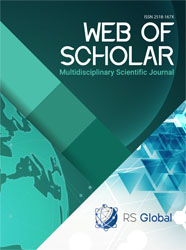CORRUPTION NETWORKS: HOW IT REMAINS DOING AND PERSISTS
Abstract
Using the well-known three-tier model of corruption, we analyze the construction of an elementary corruption network. Considering the public choice theory and the organization culture theory as our theoretical basis, we propose principles of the corruption network functionality, including horizontal links which provide participants with the necessary protection from the risks of been exposed. Elementary corruption networks use organizational mechanisms which, despite the rigid rules of functioning, make them sufficiently flexible and secure. At the same time, even though the main “productive force” of the system is the vertical “client-agent” relationship, the networks, through horizontal links, can unite, spreading out towards many influential spheres of society, where they support each other and thus stay viable. In such an environment the fight against corruption seem to be a simple demonstration of the network’s strength, which gets rid of the participants who violate “rules of the game”.
References
Abbink, K. (2002). Fair salaries and the moral costs of corruption. Retrieved from http://www.nottinghampublications.com/economics/cedex/papers/2002-05.pdf
Ajit Mishra (2006). Corruption, hierarchies and bureaucratic structure. In International Handbook on the Economics of Corruption / edited by Susan Rose-Ackerman (pp. 189-215). Cheltenham, UK; Northampton, MA, USA: Edward Elgar Publishing, Inc.
Carrillo Juan D. (2000) Corruption in Hierarchies. Annales D’Économie et de Statistique. 59, 37-62.
Chayes, S. (2016, June). The Structure of Corruption: A Systemic Analysis Using Eurasian Cases. Carnegie Endowment for International Peace. 79.
Gjalt de Graaf. (2007) Causes of Corruption: Towards a Contextual Theory of Corruption. Vrije Universiteit Amsterdam. Public Administration Quarterly, Vol. 31, No. 1, p.39-86. Retrieved from https://spaef.org/article/751/Causes-of-Corruption:--Towards-a-Contextual-Theory-of-Corruption
Gong Ting and Wu Alfred M. (2012) Does Increased Civil Service Pay Deter Corruption? Evidence from China. Review of Public Personnel Administration. 32(2) 192–204. DOI: 10.2139/ssrn.2158530
Mashal, A. & Shafiq, S. (2014) The Impact of Organizational Culture on Organizational Performance: A Case Study of Telecom Sector. Global Journal of Management and Business Research: Administration and Management. 14, 3, 1.0, 21-30.
Pinto, J., Leana C. R. & Pil, F. K. (2008). Corrupt Organizations or Organizations of Corrupt Individuals? Two Types of Organization-level Corruption. Academy of Management Review. 33, 3, 685–709.
Prevention of fraud, corruption and bribery committed through legal entities for the purpose of financial and economic gain. Comparative Overview (2012, October 26). Center for International and European Law. The Polish Institute of International Affairs. (121) 20. Retrieved from http://www.asser.nl/upload/documents/20121205T032523-Comparative%20Overview%2026%20Oct%202012%20final.pdf
Rijckeghem, C. V., & Weder, B. (2001). Bureaucratic corruption and the rate of temptation: Do wages in the civil service affect corruption, and by how much? Journal of Development Economics, 65(2), 307-331.
Schein, E. H. (1990). Organizational culture. American Psychological Association, 45(2), 109-119.
The Most Corrupt Countries in the World (2018). Ranker. Retrieved from https://www.ranker.com/list/the-most-corrupt-countries-in-the-world/info-lists
The World Bank. Country Indicators (2018). Retrieved from https://data.worldbank.org/indicator/
Transparency International (2018/1). Corruption Perception Index 2017. Retrieved from https://ti-ukraine.org/cpi2017/#/
Transparency International (2018/2). What is corruption? Retrieved from https://www.transparency.org/what-is-corruption
Vannucci Alberto (2015). Three paradigms for the analysis of corruption. Labour and Law Issues. 1, 2, 31.
Vargas-Hernández J. G. (2009, October 21). The Multiple Faces of Corruption: Typology, Forms and Levels. SSRN Electronic Journal. 20. · doi: 10.2139/ssrn.1413976.
Wensink, W, Maarten de Vet, J. et al. (2013, June 30) Identifying and Reducing Corruption in Public Procurement in the EU. Development of a methodology to estimate the direct costs of corruption and other elements for an EU- evaluation mechanism in the area of anti-corruption. PwC. 371, 20. Retrieved from https://dspace.library.uu.nl/bitstream/handle/1874/309580/identifying_reducing_corruption_in_public_procurement_en.pdf?sequence=1&isAllowed=y
Views:
327
Downloads:
193
Copyright (c) 2019 The authors

This work is licensed under a Creative Commons Attribution 4.0 International License.
All articles are published in open-access and licensed under a Creative Commons Attribution 4.0 International License (CC BY 4.0). Hence, authors retain copyright to the content of the articles.
CC BY 4.0 License allows content to be copied, adapted, displayed, distributed, re-published or otherwise re-used for any purpose including for adaptation and commercial use provided the content is attributed.











